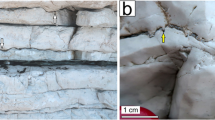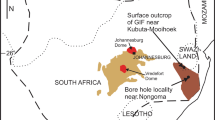Abstract
Micrometeorites—submillimetre-sized particles derived from asteroids and comets1,2,3,4,5—occur in significant quantities in deep sea sediments1,2,4, and the ice sheets of Greenland6,7 and Antarctica8,9. The most abundant micrometeorites are cosmic spherules3, which contain nickel-rich spinels10 that were crystallized and oxidized during atmospheric entry, therefore recording the oxygen content in the uppermost atmosphere10,11,12. But the use of micrometeorites for detecting past changes in the flux of incoming extraterrestrial matter, and as probes of the evolution of the atmosphere, has been hampered by the fact that most objects with depositional ages higher than 0.5 Myr show severe chemical alteration2. Here we report the discovery of unaltered cosmic spherules in a 1.4-Gyr-old13,14,15 sandstone16,17 (red bed) from Finland. From this we infer that red beds, a common lithology in the Earth's history, may contain substantial unbiased populations of fossil micrometeorites. The study of such populations would allow systematic research on variations in the micrometeorite flux from the early Proterozoic era to recent times9 ( a time span of about 2.5 Gyr), and could help to better constrain the time when the atmospheric oxygen content was raised to its present level18,19,20.
This is a preview of subscription content, access via your institution
Access options
Subscribe to this journal
Receive 51 print issues and online access
$199.00 per year
only $3.90 per issue
Buy this article
- Purchase on Springer Link
- Instant access to full article PDF
Prices may be subject to local taxes which are calculated during checkout

Similar content being viewed by others
References
Blanchard, M. B., Brownlee, D. E., Bunch, T. E., Hodge, P. W. & Kyte, F. T. Meteoroid ablation spheres from deep-sea sediments. Earth Planet. Sci. Lett. 46, 178–190 (1980).
Taylor, S. & Brownlee, D. E. Cosmic spherules in the geologic record. Meteoritics 26, 203–211 (1991).
Brownleee, D. E., Bates, B. & Schramm, L. The elemental composition of stony cosmic spherules. Meteoritics Planet. Sci. 32, 157–175 (1997).
Brownlee, D. E. in The Sea Vol. 7(ed. Emilinani, C.) 733–762 (Wiley, New York, (1981)).
Brownlee, D. E. Cosmic dust: collection and research. Annu. Rev. Earth Planet. Sci. 13, 147–173 (1985).
Maurette, M., Jéhanno, C., Robin, E. & Hammer, C. Characteristics and mass distribution of extraterrestrial dust from the greenland ice cap. Nature 328, 699–702 (1987).
Robin, E., Christophe Michel-Levy, N., Bourot-Denise, M. & Jéhanno, C. Crystalline micrometeorites from Greenland blue lakes: their chemical composition, mineralogy and possible origin. Earth Planet. Sci. Lett. 97, 162–176 (1990).
Maurette, M.et al. Acollection of diverse micrometeorites recovered from 100 tonnes of Antarctic blue ice. Nature 351, 44–46 (1991).
Taylor, S., Lever, J. H. & Harvey, R. P. Accretion rate of cosmic spherules measured at the South Pole. Nature 392, 899–902 (1998).
Robin, E., Bontè, Ph., Froget, L., Jéhanno, C. & Rocchia, R. Formation of spinels in cosmic objects during atmospheric entry: A clue to the Cretacious-Tertiary boundary event. Earth Planet. Sci. Lett. 108, 181–190 (1992).
Gayraud, J., Robin, E., Rocchia, R. & Froget, L. Formation conditions of oxidized Ni-rich spinel and their relevance to the K/T boundary event. Geol. Soc. Am. Spec. Pap. 307, 425–443 (1996).
Brownlee, D. E., Bates, B. A. & Wheelock, M. M. Extraterrestrial platinum group nuggets in deep-sea sediments. Nature 309, 693–695 (1984).
Suominen, V. The chronostratigraphy of southwestern Finland, with special reference to Postjotnian and Subjotnian diabases. Geol. Surv. Fin. Bull. 304((1991)).
Amatov, A., Laitakari, I. & Prooshin, Ye. in Explanation to the Map of Precambrian Basement of the Gulf of Finland and Surrounding Area 1:1 mil (ed. Koistinen, T.) Geol. Surv. Finl. Spec. Pap. 21, 99–113 (1996).
Neuvonen, K. J. Remanent magnetization of the Jotnian sandstone in Satakunta, SW-Finland. Bull. Geol. Soc. Fin. 45, 23–27 (1973).
Marttila, E. Satakunnan hiekkakiven sedimentaatio-olosuhteista. (On the sedimentary environment of the Satakunta sandstone.)Thesis, Univ. Turku ((1969)).
Kohonen, J., Pihlaja, P., Kujala, H. & Marmo, J. Sedimentation of the Jotnian Satakunta sandstone, western Finland. Geol. Surv. Fin. Bull. 369((1993)).
Des Marais, D. J., Strauss, H., Summons, R. E. & Hayes, J. M. Carbon isotope evidence for the stepwise oxidation of the Proterozoic environment. Nature 359, 605–609 (1992).
Kasting, J. F. Earth's early atmosphere. Science 259, 920–926 (1993).
Ohmoto, H. When did the Earth's atmosphere become oxic? Geochem. News 93, 12–27 (1997).
Jéhanno, C., Boclet, D., Bonté, Ph., Castellarin, A. & Rocchia, R. Identification of two populations of extraterrestrial particles in a Jurassic hardground of the Southern Alps. Proc. Lunar Planet. Sci. Conf. 18, 623–630 (1988).
Marttila, E. Mikrometeorlitteja Satakunnan kiekkakivessä. (Micrometeorites in the Satakunta sandstone.) Geologi 20, 135–136 (1968).
Steele, I. M. Olivine in Antarctic micrometeorites: Comparison with other extraterrestrial olivine. Geochim. Cosmochim. Acta 56, 2923–2929 (1992).
Beckerling, W. & Bischoff, A. Occurrence and composition of relict minerals in micrometeorites from Greenland and Antarctica—Implication for their origjns. Planet. Space Sci. 43, 435–449 (1995).
Brownlee, D. E., Bates, B. & Beauchamp, R. H. in Chondrules and their Origin (ed. King, E. A.) 122–133 (Lunar and Planetary Inst., Houston, (1983)).
Love, S. G. & Brownlee, D. E. Heating and thermal transformation of micrometeoroids entering the Earth's atmosphere. Icarus 89, 26–43.
Thorslund, P. & Wickman, F. E. Middle Ordovician chondrite in fossiliferous limestone from Brunflo, central Sweden. Nature 289, 285–286 (1981).
Goodwin, A. M. Precambrian Geology; the Dynamic Evolution of the Continental Crust (Academic, San Diego, (1991)).
Bence, A. E. & Albee, A. L. Empirical correction factors for the electron microanalysis of silicates and oxides. J. Geol. 76, 382–403 (1968).
Kerridge, J. F. & Matthews, M. S. (eds) Meteorites and the Early Solar System Appendix 3 (Univ. Arizona Press, Tucson, (1988)).
Acknowledgements
We thank T. Grund, F. Bartschat, U. Heitmann, M. Flucks and D. Kettrup for technical assistance, and A. Bischoff, E. Marttila, A. Putnis, U. Schärer, and H. Strauss for discussions. Field work was supported by a DAAD-Finish Academy of Science exchange program (A.D. and L.J.P.) and we acknowledge additional support by DFG.
Author information
Authors and Affiliations
Corresponding author
Additional information
We earlier reported finding unaltered cosmic spherules in samples from the Satakunta sandstone, Finland1. At that time, we had found 18 spherules in 5 kg of material, and an additional 100 spherules were recovered from the 60–125 m heavy mineral separates of the samples. Rocks collected later from the same and nearby sites had no spherules in them2. We have subsequently concluded that the cosmic spherules1 were not part of the Satakunta sandstone samples. The total number of spherules we found during processing in the Muenster laboratory (about 120) is in itself a compelling argument for an exceptional contamination.
About this article
Cite this article
Deutsch, A., Greshake, A., Pesonen, L. et al. RETRACTED ARTICLE: Unaltered cosmic spherules in a 1.4-Gyr-old sandstone from Finland. Nature 395, 146–148 (1998). https://doi.org/10.1038/25943
Received:
Accepted:
Issue Date:
DOI: https://doi.org/10.1038/25943
This article is cited by
-
Tracing the oxygen isotope composition of the upper Earth’s atmosphere using cosmic spherules
Nature Communications (2017)
-
Correction: Retraction: Unaltered cosmic spherules in a 1.4-Gyr-old sandstone from Finland
Nature (2004)
-
Ancient cosmic spherules
Nature (1998)
Comments
By submitting a comment you agree to abide by our Terms and Community Guidelines. If you find something abusive or that does not comply with our terms or guidelines please flag it as inappropriate.



